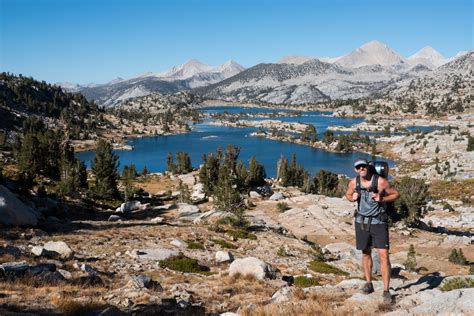The John Muir Trail (JMT) is an iconic, 211-mile long, backcountry trail that passes through some of the most spectacular scenery in the United States. From its beginning in Yosemite Valley in the Sierra Nevada Mountains of California to its end at the summit of Mount Whitney, the highest peak in the contiguous United States, the JMT offers hikers an amazing experience of nature.
But the JMT is also considered a challenging hike because of its length, and the fact that the terrain is often very rugged. The trail passes through some of the highest peaks in the Sierra, including Mount Whitney, Forester Pass (13,100 feet), and Muir Pass (11,955 feet). The trail also passes through some of the deepest canyons, including Kings Canyon and the Kern Canyon. The elevation gain and loss along the trail total about 38,000 feet, and the average hiking time is 26 days from start to finish.
In addition to the terrain, the weather along the JMT can also be challenging. The high altitude in the Sierra Nevada means that temperatures vary significantly during the day, and nights can be quite cold. Snow can be encountered any time of the year, and thunderstorms with hail and lightning can be very dangerous.
Preparing for the JMT can also be a challenge. The trail is not maintained, so it is important to research the latest trail conditions before starting. It is also important to make sure you are physically and mentally prepared for the challenge of the hike; the high elevation, rugged terrain, and changing weather can be very taxing.
The John Muir Trail is a spectacular hike and a life-changing experience for those who conquer it. While it is a difficult hike, the rewards are worth the effort. With proper planning and preparation, a hiker can have an amazing experience and come away from the trail with a renewed appreciation for the beauty and majesty of the Sierra Nevada.
The Physical Challenge of the John Muir Trail
The John Muir Trail (JMT) is a 211-mile long-distance hiking trail that takes hikers through some of the most stunning landscapes in the United States. It winds its way through the Sierra Nevada Mountains in California, from Yosemite Valley to Mount Whitney, the highest mountain in the continental United States.
The John Muir Trail is an iconic adventure and a physically demanding undertaking. It takes an average of three weeks or more to complete, and requires a high level of physical fitness. The elevation gains and losses encountered on the trail are extensive, and the terrain is often steep and covered in snow. In some sections, hikers must negotiate ridges, creeks, and waterfalls. In order to complete the entire JMT, hikers must be prepared for both the physical and mental challenges of the trail.
The John Muir Trail is no walk in the park. It requires a significant level of fitness to tackle the trail’s steep terrain and elevation gains and losses. The average elevation of the trail is over 8,000 feet, and the highest point is 13,000 feet. The total elevation gain along the trail is over 43,000 feet. An average day on the trail will involve over 1,000 feet of elevation gain and loss.
The terrain can be tough to navigate. Most of the trail is above 9,000 feet, and is often covered in snow and ice. Hikers must be prepared for extreme weather conditions, as temperatures can range from scorching hot in the day to below freezing at night. Hikers must also be aware of altitude sickness, which can be serious if not treated properly.
Fitness and preparation are key to tackling the physical challenge of the JMT. Hikers should be in excellent physical condition and should have a good understanding of what to expect on the trail. The trail can be a daunting prospect for those who are not prepared for the challenge, so it’s important to research the trail thoroughly before attempting it.
In addition to the physical challenge, the John Muir Trail also presents a mental challenge. It’s a long and arduous journey, and it can be daunting to think about the challenges that lie ahead. Hikers must be mentally prepared for the challenges they will face on the trail.
The mental challenge of the JMT can be just as difficult as the physical challenge. Hikers must be prepared to push themselves and stay motivated to reach the end of the trail. It’s important to stay positive and focus on the goal of completing the trail, rather than on the obstacles encountered along the way.
The John Muir Trail is an iconic adventure and a physically and mentally demanding undertaking. The elevation gains and losses encountered on the trail are extensive, and the terrain is often steep and covered in snow. In order to complete the entire JMT, hikers must be prepared for both the physical and mental challenge of the trail. Fitness and preparation are key to tackling the physical challenge of the JMT, and hikers must be mentally prepared for the challenges they will face on the trail.
Navigating the John Muir Trail: Tips for Hikers
The John Muir Trail (JMT) is one of the most popular hiking trails in North America, and for good reason. It’s a 210-mile journey that winds through some of the most stunning landscapes in the Sierra Nevada. Hikers tackle the challenging terrain and extreme weather conditions, and come out with a sense of accomplishment and rejuvenation. If you’re planning a hike along the JMT, here are some tips to help make the trip a success.
Understand the challenges of the John Muir Trail
The John Muir Trail is an arduous journey that will test your physical and mental endurance. The terrain can be tough, with steep inclines and declines, and the weather can be unpredictable. You’ll need to plan your hike carefully to make sure you have enough food, water, and shelter. Make sure you’re prepared for a range of temperatures, as the climate can vary greatly depending on elevation.
Prepare for the Journey
Before you set off on your John Muir Trail hike, make sure you have all the necessary gear. You’ll need a pack with plenty of room for extra clothes, food, and water, along with a sleeping bag and shelter. You’ll also want to make sure you have maps and a compass, and consider bringing a GPS device so you can track your progress. If you’re camping, make sure you have a camp stove and fuel, as well as bear-proof containers for storing food and other items.
Choose the Right Route
The John Muir Trail is divided into two sections: the Tahoe-Yosemite and the Yosemite-Mount Whitney. Depending on your experience level and time constraints, you may want to choose one section or the other. Generally, the Tahoe-Yosemite section is easier, with more gradual elevation changes and fewer passes. The Yosemite-Mount Whitney section is more difficult, with higher elevation gains and steeper passes.
Know Your Limits
Hiking the John Muir Trail should not be taken lightly. Make sure you understand your physical fitness and experience level before attempting the trail. Pay attention to your body and take breaks when necessary. If you’re feeling tired or sore, take a break and re-evaluate your plan. Remember, the journey is just as important as the destination, so take the time to savor the views and appreciate the beauty of the Sierra Nevada.
Safety First
| Item | Description |
|---|---|
| Clothing | Bring enough layers to keep you warm and dry. |
| Lighting | Carry a headlamp or flashlight in case you’re out after dark. |
| Communication | Bring a cell phone or a two-way radio in case of emergency. |
| First Aid | Pack a first-aid kit with basic supplies and medicines. |
No matter how prepared you are, something unexpected can happen. Make sure you have the proper gear and clothing for any situation. Pack a headlamp, flashlight, first-aid kit, and communication device in case you find yourself in an emergency. Check the weather before you leave and be prepared for changes in the forecast.
Hiking the John Muir Trail is an amazing journey that will stay with you for a lifetime. With a little preparation and some basic safety tips, you can make sure your trip is a success. Keep these tips in mind as you plan your next adventure along the JMT.
 Road Topic Tourism & Travel
Road Topic Tourism & Travel




